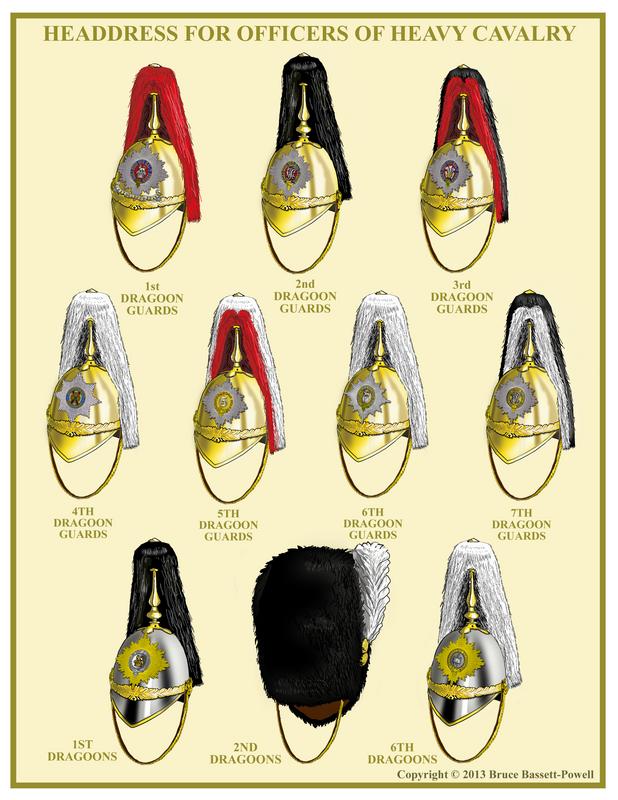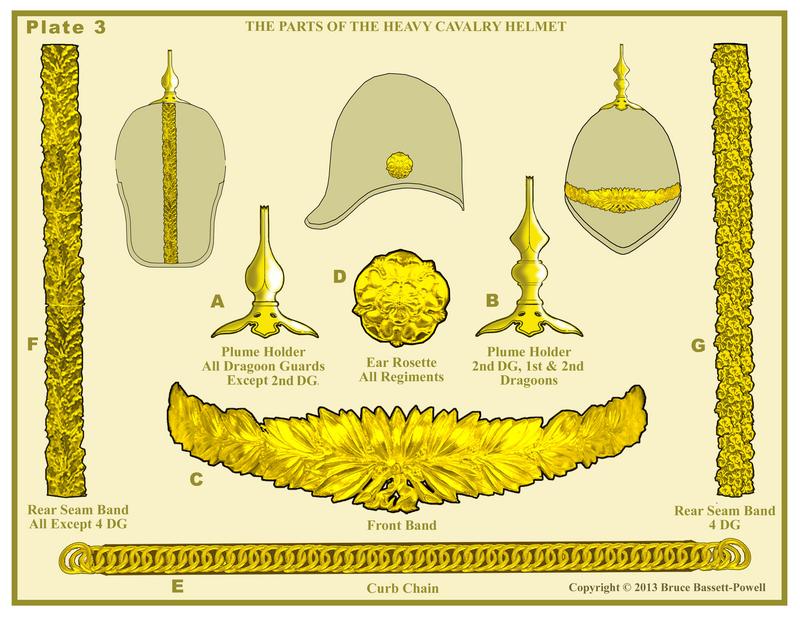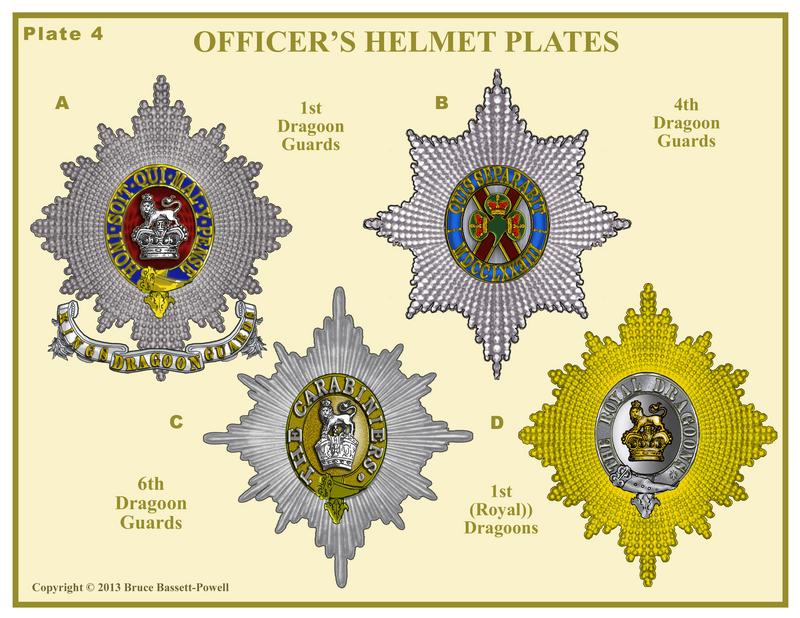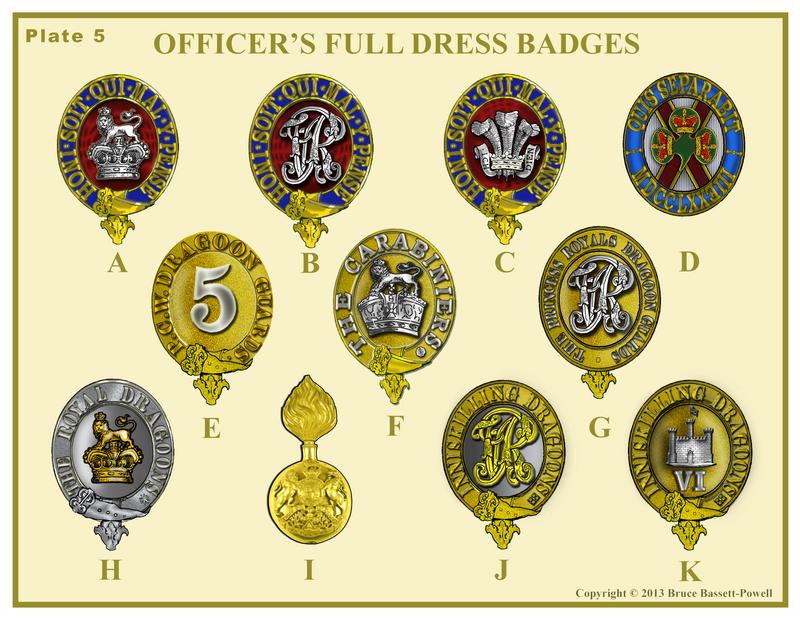UNIFORMS OF DRAGOON GUARDS & DRAGOONS
The ten regiments of Dragoon Guards and Dragoons had retained their structure as heavy cavalry regiments since 1816, despite an attempt to re-role the 6th Dragoon Guards as Light Dragoons in 1854. In 1881, the regiments were as follows:-
1st (King's) Dragoon Guards
2nd Dragoon Guards (The Queen's Bays)
3rd (Prince of Wales's) Dragoon Guards
4th (Royal Irish) Dragoon Guards
5th (Princess Charlotte of Wales's) Dragoon Guards
6th Dragoon Guards (Carabiniers)
7th (Princess Royal's) Dragoon Guards
1st Royal Dragoons
2nd Dragoons (Royal Scots Greys)
6th (Inniskilling) Dragoons
These regiments were distinguished from other cavalry regiments by their plumed metal helmets and red tunics, with the notable exceptions of the 6th Dragoon Guards who wore blue tunics in memory of their brief existence as light cavalry and the 2nd Dragoons who wore bearskin caps, continuing their privilege to wear the grenadier headdress since the early 18th century.
Despite the basic distinctions, the differences in details between the regiments were, by comparison with almost any other army in the world, vast. From the nominal differences between Dragoon Guards and Dragoons, such as yellow-metal helmets for dragoon guards and white-metal for dragoons and velvet facings for the former and cloth for the latter, every regiment had different badges for various items, gold lace patterns and mess waistcoat patterns. These will all be described in the following account beginning with officers' headdresses. (Please note: Regiments full titles will not always be used. Abbreviated titles such as 1DG, 2DG, 1D and 2D may be used.
OFFICERS' FULL DRESS HEADDRESS
Helmets were gilded metal for Dragoon Guards and German silver for Dragoons and the fittings for all helmets were gilt or gilding metal. It was fitted with a spike on a four pointed acanthus leaf base. For seven of the regiments the spike screwed right into the base but for the 2nd Dragoon Guards and the 1st & 6th Dragoons there was a sphere between the spike and the base. There was a laurel leaf pattern decoration across the front from side to side, each fitted with a rosette to which was attached the curb chain. On the back seam was an inch wide oak leaf bar from the spike base to the helmet rim. For the 4th Dragoon Guards, the bar was of shamrocks (See Plate 3 for details).
The plume was made of horse hair and the colours for each regiment were as follows:-
1st Dragoon Guards -  Red,
Red,
2nd Dragoon Guards -White
-White
3rd Dragoon Guards - Black over Red,
Black over Red,
4th Dragoon Guards - White
White
5th Dragoon Guards - White over Red,
White over Red,
6th Dragoon Guards - White
White
7th Dragoon Guards - Black over White
1st Dragoons' - Black
6th Dragoons - White
(See Plates 1 & 2)
The 2nd Dragoons wore the bearskin cap with a white egret feather plume on the left fitted into a gilt grenade plume holder. There are no dimensions of the cap in the 1883 regulations but by 1900 it states the the cap should be 9.5 inches high for officers 5 ft 6ins tall varying to 11 ins for those over 6 ft.
PLATE 2
HELMET PLATES & BADGES
The first pattern Albert helmet of 1847 had borne a diamond cut eight-pointed star (silver for dragoon guards, gilt for dragoons) on the front which was almost wholly covered by an oval device in gilt, in the centre of which was the Royal Cypher (VR) on a frosted gilt ground with the strap bearing the regimental title. This was the same for all regiments, although some surviving examples suggest differences such as the 6th Dragoons where the star is silver and the centre device is the Castle of Inniskilling.
The 1871 pattern helmet plate is described in the 1874 dress regulations for dragoon guards as "A diamond cut silver star in front with the regimental device or number in the centre, within a garter bearing the title of the regiment". Regiments of dragoons were described as having the same helmets (in white metal) but with "gilt ornaments".
By 1881, with the Childers reforms removing a great deal of individuality, especially in the infantry but less so in the cavalry, the importance of regimental badges began to increase. At the turn of the century, each of the heavy cavalry regiments had a badge distinctive to their regiment in many details.
1st (King's) Dragoon Guards
In 1881 the helmet plate was a diamond cut, twelve pointed Garter Star in silver with the oval Garter belt of blue enamel edged in gilt. On the belt, the motto "HONI SOIT QUI MAL Y PENSE" in gilt. Within the garter the Royal Cypher (VR) in silver on a red enamel centre flecked with blue. Beneath the badge on the lower part of the star, a three part silver scroll with the title "KING'S DRAGOON GUARDS" in gilt. By the 1890s the VR cypher had been replaced by the Royal Crest in silver. Almost certainly, both devices were worn concurrently before all officers wore the crest device.
2nd Dragoon Guards (The Queen's Bays)
The helmet plate was a diamond cut Garter Star in silver with the oval Garter belt of blue enamel edged in gilt. On the belt, the motto "HONI SOIT QUI MAL Y PENSE" in gilt. Within the garter the Royal Cypher (VR) in silver on a red enamel centre flecked with blue. There were no apparent changes to this device during the period.
3rd (Prince of Wales's) Dragoon Guards
Sometime after 1871, the 3rd Dragoon Guards had replaced the VR cypher with the Prince of Wales's plumes with the motto "ICH DIEN" in silver. This badge on a red enamel ground with the rest of the plate like the 2nd Dragoon Guards remained constant during the period..
4th (Royal Irish) Dragoon Guards
Instead of the Garter Star, the helmet plate was the diamond cut, eight pointed star of the Order of St. Patrick. In the center was the cross of St. Patrick in red on a ribbed silvered ground. Upon the cross a green shamrock with a crown in proper colours on each leaf. Around this was a pale blue circlet edged with gilt pierced with the motto "QUIS SEPARABIT" above and "MDCCLXXXIII" below also in gilt. This plate remained unchanged until amalgamation in 1922.
5th (Princess Charlotte of Wales's) Dragoon Guards
A diamond cut star like that of the 2nd Dragoon Guards is the plate while the centre consists of a frosted gilt ellipse surrounded by a strap. On the centre is a silver "5" and upon the strap is the title "P.C.W. DRAGOON GUARDS" in silver. The VR cypher may have been the centre before 1885 but the "5" remained in use for most of the period.
6th Dragoon Guards (Carabiniers)
This regiment had a plain rayed silver star with twelve points with a frosted gilt centre & strap. On the strap, the title "THE CARABINIERS" in silver and in the centre an Imperial Crest in silver. Dress regulations of 1900 described the centre as being the VR cypher on a red enamel ground but no example or illustration has been seen with this plate.
7th (Princess Royal's) Dragoon Guards
The plate of the 7th regiment was similar to that of the 5th Dragoon Guards. Instead of a strap, however there was a ring with the title "THE PRINCESS ROYAL'S DRAGOON GUARDS" in silver. In the centre was the silver VR cypher.
1st Royal Dragoons
The plate was a gilt twelve pointed star. (Instead of being "diamond cut" the star is described as being "beaded" or "rounded"). In the centre an elliptical strap in silver with the title "THE ROYAL DRAGOONS" in gilt. Within the ellipse, a Royal Crest in gilt.
2nd Dragoons (Royal Scots Greys)
As they wore the bearskin, the Greys' badge was a gilt grenade into which the white plume was inserted. On the ball of the grenade was the Royal Arms below which was St. Andrew with his Cross and thistles either side. All in gilt.
6th (Inniskilling) Dragoons.
The gilt twelve pointed star with an elliptical ring in the centre. The strap was frosted gilt with the title "INNISKILLING DRAGOONS" also in gilt. On a polished silver centre was the VR cypher in gilt. Later, the centre changed to the Castle of Inniskilling in with the Roman numerals "IV" beneath in silver, all on a gilt ground. This badge was in wear by the end of Queen Victoria's reign.
.
A: 1st Dragoon Guards B: 2nd Dragoon Guards C: 3rd Dragoon Guards D: 4th Dragoon Guards
E: 5th Dragoon Guards F: 6th Dragoon Guards G: 7th Dragoon Guards
H: 1st Dragoons I: 2nd Dragoons J: 6th Dragoons (Pre 1885) K: 6th Dragoons (Post 1885)
PLATE 3
HEAVY CAVALRY UNIFORMS, ARMS & EQUIPMENT DRAGOON GUARDS AND DRAGOONS







